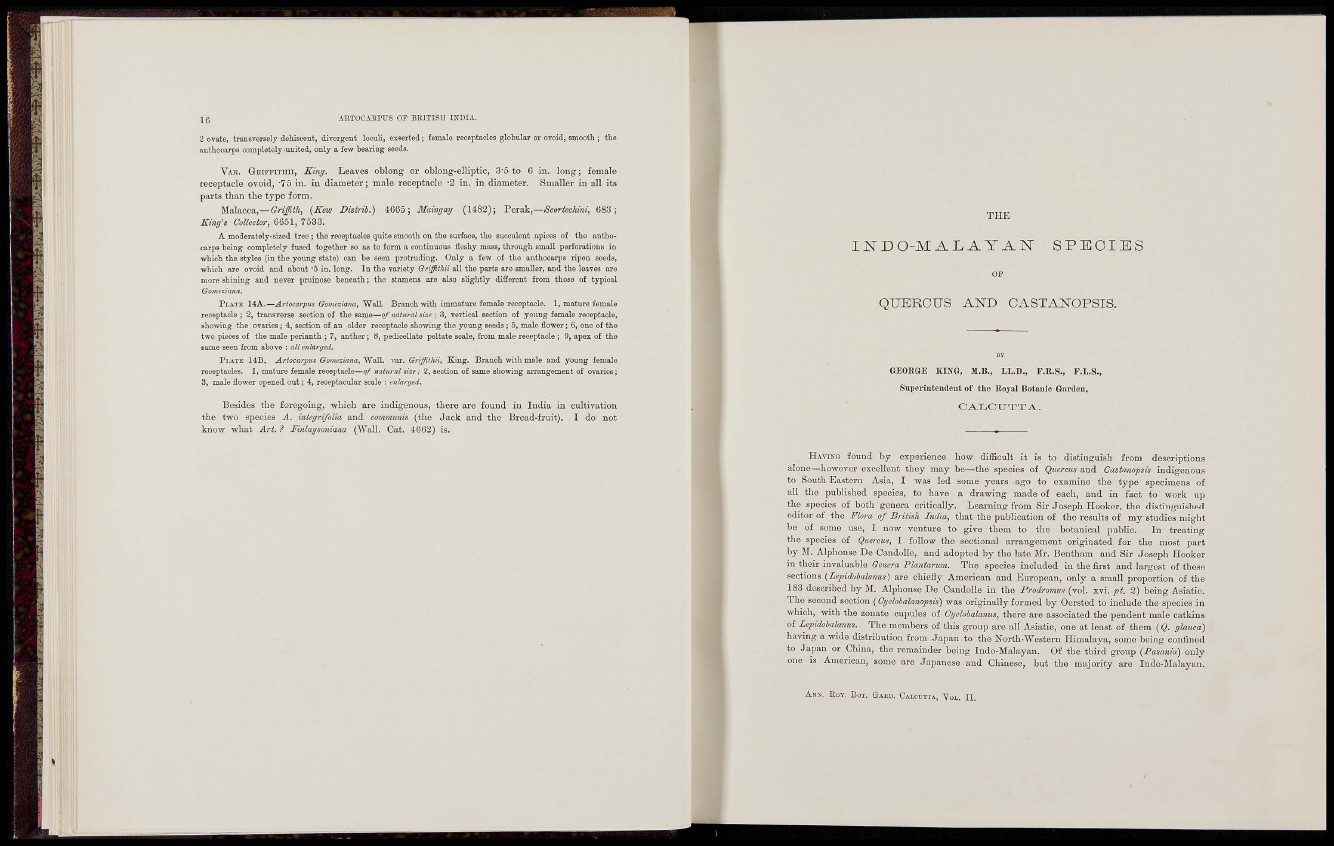
ABTOCAEPÜS OP EKITISH INDIA.
2 ovate, transversely dehiscent, divergent locull, esserted; female receptacles globular or ovoid, smooth ; the
antliocarps completely .united, only a few beaiing seeds.
VAR. GEiFFiTmi, King. Leaves oblong or oblong-elliptic, 3'5 to 6 in. long; female
receptacle ovoid, -75 in. in diameter; male receptacle -2 in. in diameter. Smaller in all its
parts than the type form.
M a l a c c a , — { K m Distrib.) 4665; Maingay (1482); P e r a k , — 6 8 3 ;
Kingh Collector, 6651, 7533.
A moderately-sized tree; the receptacles quite smooth on the surface, the succulent apices of the anthocarpa
being completely fused together so as to form a continuous fleshy mass, through small perforations in
which the styles (in the young state) can be seen protruding. Only a few of the anthocarps ripen seeds,
which are ovoid and about -5 in. long. In the variety Griffithii all the parts are smaller, and the leaves are
more shining and never pruinose beneath; the stamens are also slightly diGerent from those of typical
Gomeziana.
P l a t e 14A.—Artocarpus Oomesiana, Wall. Branch with immature female receptacle. 1, mature female
receptacle ; 2, transverse section of the same—of natural size; 3, vertical section of young female receptacle,
showing the ovaries; 4, section of an older receptacle showmg the young seeds; 5, male flower; 6, one of the
two pieces of the male perianth ; 7, anther; 8, pedicellate peltate scale, from male receptacle ; 9, apex of the
game seen from above : all enlarged.
Pi,ATE 14B, Artocarptis Oomeziana, Wall. var. Griffithii, King. Branch with male and young female
receptacles. 1, mature female receptacle—of natural size; 2, section of same showing arrangement of ovaries;
3, male flower opened out; 4, receptacular scale : enlarged.
! the
the two species A.
know what Art.
which are indigenous, there are found in India in cultivation
and eommimis (the Jack and the Bread-fruit). I do not
; (Wall. Cat. 4662) is.
T H E
i j S T D O - M A L A T A I S r SPECIES
OF
QUERO US AND CASTAN0P8IS.
GEORGE KliiG, M.B., Ll.D., F.R.S., F.L.S.,
Superintendent of tlie Boyal Botanic Qardeu,
C ^ I ^ C T T T T A . .
HAVING found by experience how difficult it is to distinguish from descriptions
alone—however escellent they may be—the species of Quercus and Castanopsis indigenous
to South Eastern Asia, I was led some years ago to examine the type specimens of
all the published species, to have a drawing made of each, and in fact to work up
the species of both genera critically. Learning from Sir Joseph Hooker, the distinguished
editor of the Flora of British India, that the publication of the results of my studies might
be of some use, I now venture to give them to the botanical public. In treating
the species of Quercus, I follow the sectional arrangement originated for the most part
by JI. Alphonse De Candolle, and adopted by the late Mr. Bentham and Sir Joseph Hooker
in their invaluable Genera Plantarum. The species included in the first and largest of these
sections {Lepidubalanus) are chiefly American and European, only a small proportion of the
183 described by M. Alphonse De Candolle in the Prodromvs (vol. xvi. pt. 2) being Asiatic.
The second section {Cyclohalanopsis) was originally formed by Oersted to include the species in
which, with the zonate cupules of Oychbalanus, there are associated the pendent male catkins
of Lepidobalams. The members of this group are all Asiatic, one at least of them {Q. glauca)
having a wide distribution from Japan to the North-Western Himalaya, some being confined
to Japan or China, the remainder being Indo-Malayan. Of the third group \Pasania) only
one is American, some are Japanese and Chinese, but the majority are Indo-Malayan.
ANN. Roy. BOX. GXZV. CALCVTXA, YOL. II.